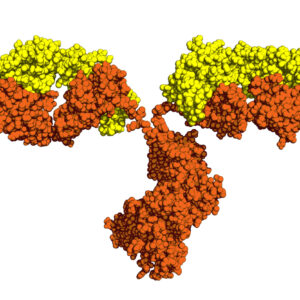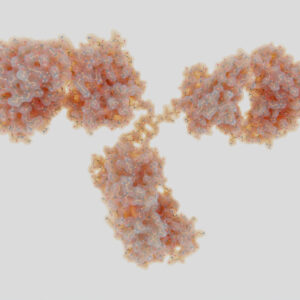Porcine Coronavirus
There are six known coronaviruses circulating in swine that affect respiratory and gastrointestinal health. Four porcine coronaviruses are associated with digestive disorders (TGEV, PEDV, PDCoV and SADS-CoV). Porcine respiratory coronavirus (PRCV) is associated with respiratory problems, and PHEV virus gives rise to two different syndromes, vomiting/wasting disease and encephalomyelitis. Some of these viruses have only recently emerged and are now responsible for widespread economic losses in the pork industry across the world, causing high morbidity and mortality, particularly in neonatal pigs.
Porcine Coronavirus Background
Porcine coronaviruses can be divided into respiratory (PRCoV) and enteropathogenic coronaviruses such as transmissible gastroenteritis virus (TGEV), porcine epidemic diarrhea virus (PEDV) and porcine deltacoronavirus (PDCoV) (Gerdts & Zakhartchouk, 2017). Currently, six coronaviruses infect pigs, including four alphacoronaviruses [(transmissible gastroenteritis virus (TGEV), porcine respiratory coronavirus (PRCV), porcine epidemic diarrhea virus (PEDV), and swine acute diarrhea syndrome-coronavirus (SADS-CoV)], one betacoronavirus [porcine hemagglutinating encephalomyelitis virus (PHEV)], and a porcine deltacoronavirus (PDCoV). Among them, TGEV, PRCV, and PHEV have been circulating in pigs for decades, whereas PEDV, PDCoV, and SADS-CoV are considered emerging coronaviruses, causing acute gastroenteritis in neonatal piglets (Wang et al., 2019). PEDV and PDCoV are major causative agents of lethal watery diarrhea in piglets, leading to significant losses within the swine industry worldwide (Woo et al., 2009; Woo et al., 2012; Zhang & Yoo, 2016). SADS-CoV was identified as the etiological agent responsible for a large-scale outbreak of fatal disease in pigs in China that caused the death of more than 20,000 piglets (Zhou et al., 2018). These emerging porcine coronaviruses are only known to infect pigs, and do not infect humans (Wang et al., 2019).
Transmission is mainly via the fecal-oral route although vomitus, and contaminated fomites may also be involved (Koonpaew et al., 2019). PEDV and PDCoV primarily target the gastrointestinal tract of pigs, although PEDV has also been found to infect alveolar macrophages of the respiratory tract resulting in pneumonic lesions. The major determinant for attachment and entry is binding of the Spike (S) glycoprotein to receptors on the cell surface. The S protein is a type I glycoprotein consisting of S1 and S2 subunits present on the virion surface as a trimer. The S1 is involved in receptor binding and contains N-terminal and C-terminal domains (S1-NTD and S1-CTD, respectively), both of which may serve as a receptor-binding domain (RBD). The S2 subunit forms the stalk of the spike trimer, involved in triggering the fusion of the viral envelope and target cell membrane. Identification of specific viral receptors can often be difficult due to the S protein potentially binding to multiple cell receptors, the necessity for co-receptors, and the involvement of potential host receptor proteins in viral replication stages other than initial binding (Wang et al., 2019). Following cell entry, porcine coronaviruses initially form double-membrane vesicles (DMVs) where replication/transcription likely takes place, assemble in the rough endoplasmic reticulum and the large virion containing vacuoles (LVCVs), and are transported via the Golgi apparatus for release by budding from the surface membrane of the infected cells (Koonpaew et al., 2019).
Clinical signs include anorexia, diarrhea and vomiting that may lead to dehydration, loss of body weight, lethargy, and death. Those clinical signs generally do not last over 10 days. Disease is generally more severe and often lethal in neonatal piglets, especially those born from seronegative sows. In older pigs, such as weaned pigs and sows, morbidity is high but the mortality rate is low. In general, the emerging highly virulent PEDV is more virulent than PDCoV strains tested (Wang et al., 2019)
Fast diagnostic assays are critical for the control of porcine coronaviruses to prevent them from spreading. No specific antiviral drugs are available to treat infected pigs and good husbandry practice and vaccines are still the best choice to prevent infections. No cross-neutralization exists between antibodies to PEDV and PDCoV or SADS-CoV and therefore require development of separate virus-specific vaccines. Vaccines exist for TGEV and PEDV but to date, no effective vaccines are available to control SADS-CoV or PDCoV outbreaks.
References
- Fan Y, Zhao K, Shi ZL, Zhou P. Bat Coronaviruses in China. Viruses. 2019;11(3):210.
- Gerdts V, Zakhartchouk A. Vaccines for porcine epidemic diarrhea virus and other swine coronaviruses. Vet Microbiol. 2017;206:45–51.
- Koonpaew S, Teeravechyan S, Frantz PN, Chailangkarn T, Jongkaewwattana A. PEDV and PDCoV Pathogenesis: The Interplay Between Host Innate Immune Responses and Porcine Enteric Coronaviruses. Front Vet Sci. 2019;6:34.
- Wang Q, Vlasova AN, Kenney SP, Saif LJ. Emerging and re-emerging coronaviruses in pigs. Curr Opin Virol. 2019;34:39–49.
- Woo PCY, Lau SKP, Huang Y, Yuen K-Y. Coronavirus diversity, phylogeny and interspecies jumping. Exp Biol Med Maywood NJ. (2009) 234:1117–27.
- Woo PCY, Lau SKP, Lam CSF, Lau CCY, Tsang AKL, Lau JHN, et al. Discovery of seven novel Mammalian and avian coronaviruses in the genus deltacoronavirus supports bat coronaviruses as the gene source of alphacoronavirus and betacoronavirus and avian coronaviruses as the gene source of gammacoronavirus and deltacoronavirus. J Virol. (2012) 86:3995–4008.
- Zhang Q, Yoo D. Immune evasion of porcine enteric coronaviruses and viral modulation of antiviral innate signaling. Virus Res. 2016;226:128–141.
- Zhou P, Fan H, Lan T, et al. Fatal swine acute diarrhoea syndrome caused by an HKU2-related coronavirus of bat origin. Nature. 2018;556(7700):255–258.
Porcine Coronavirus Antibodies
The Native Antigen Company is pleased to provide porcine coronavirus monoclonal antibodies for all of your assay development and research needs.
Questions?
Check out our FAQ section for answers to the most frequently asked questions about our website and company.


